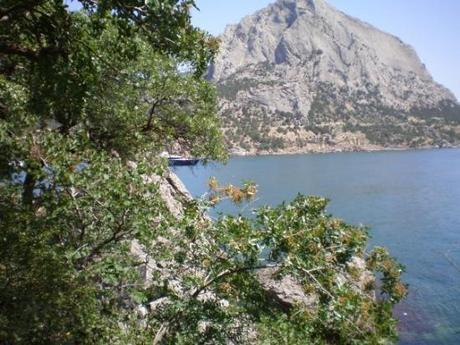Kerch
Kerch is a city on the Kerch Peninsula of eastern Crimea, an important industrial, transport and tourist centre of Ukraine. Kerch, founded 2600 years ago, is considered as one of the most ancient cities in Ukraine.
Archeological digs at Mayak village near the city ascertained that the area had already been inhabited in 17th–15th centuries BC. Kerch as a city starts its history in 7th century BC, when Greek colonists from Miletus founded a city-state named Panticapaeum on Mount Mithridat near the mouth of the Melek-Chesme river. Panticapaeum subdued nearby cities and by 480 BC became a capital of the Kingdom of Bosporus. Later, during the rule of Mithradates VI Eupator, Panticapaeum for a short period of time became the capital of much more powerful and extensive Kingdom of Pontus.
The city located at the intersection of trade routes between the steppe and Europe grew rapidly. The city's main exports were grain and salted fish, wine-making was also common. Panticapaeum minted its own coins. According to a few extant documents the Melek-Chesme river (small and shallow nowadays) was navigable in the Bosporan times, and sea galleys were able to enter the river. A large portion of the city's population was ethnically Scythian, later Sarmatian, as the large royal barrow at Kul-Oba testifies. In 1st century AD Panticapaeum and the Kingdom of Bosporus suffered from Ostrogoth raids, then the city was devastated by the Huns in AD 375.
From the 6th century the city was under Byzantine Empire control. By order of Emperor Justinian I a citadel named Bospor was built there. Bospor was the centre of a diocese and developed under the influence of Greek Christianity. In 576, it withstood a siege by the Göktürks under Bokhan, aided by Anagai, the last khan of the Uturgur Huns.
In the 7th century the Turkic Khazars took control of Bospor, and the city was named Karcha or Charsha. The main local government official during Khazar times was the tudun. Christianity was a major religion in Kerch during the period of Khazar rule. Kerch's Church of St. John the Baptist was founded in 717, thus, it is the oldest church in Ukraine. The "Church of the Apostles" existed during the late 8th century and early 9th century, according to the "Life of the Apostle Andrew" by Epiphanus. Following the fall of Khazaria to Kievan Rus' in the late 10th century, Kerch became the centre of a Khazar successor-state. Its ruler, Georgius Tzul, was deposed by a Byzantine-Rus expedition in 1016.
From the 10th century the city was a Slavic settlement named Korchev, which belonged to the Tmutarakan principality. Kerch was a center of trade between Rus', Crimea, Caucasus, and the Orient.
In the 13th century Crimea including Korchev was invaded by Mongols. After Mongols, the city became the Genoese colony of Cerco (Cherkio) in 1318 and served as a sea harbour, townspeople worked at salt-works and fishery.
In 1475 city was passed to the Ottoman Empire. During the Turkish rule Kerch fell into decay and served as a slave-market. It repeatedly suffered from raids of Zaporizhian Cossacks.
In response to strengthening of Russian military forces in Azov area, Turks built a fortress, named Yeni-kale near Kerch on the shore of Kerch Strait. The fortress was completed by 1706. In 1771 Imperial Russian Army invaded Crimea and approached Yeni-kale. The Turks decided to abandon the fortress, though reinforcements from Ottoman Empire arrived a few days before. By the Peace Treaty of Kuchuk-Kainarji in 1774, Kerch and Yenikale were ceded to Russia. As a result, the Turkish heritage has been almost completely wiped out. In 1790 Russian naval forces under the command of admiral Fyodor Ushakov defeated the Turkish fleet at the Battle of Kerch Strait.
Because of its location, from 1821 Kerch developed into an important trade and fishing port. The state museum of ancient times and a number of educational institutions were opened in the city. The ironwork factory was built in 1846 based on a huge iron ore deposit found on Kerch Peninsula.
During the Crimean War the city was devastated by British forces in 1855.
In the late 19th century, mechanical and cement factories were built, and tinned food and tobacco factories were established. By 1900, Kerch was connected to a railroad system, and the fairway of Kerch Strait was deepened and widened. At this time, the population had reached 33,000.
After suffering a decline during the First World War and the Russian Civil War, the city resumed its growth in the late 1920s, with the expansion of various industries, iron ore and metallurgy in particular, and by 1939 its population had reached 104,500.
Today Kerch is considered as a city of metallurgists, shipbuilders and fishermen. Kerch has a harbour on the Kerch Strait, which makes it a key to the Sea of Azov, several railroad terminals and a small airport. Ferry transportation across the Kerch Strait was established in 1953, connecting Crimea and the Krasnodar Krai.
Because of its location on shores of Azov and Black seas, Kerch became a popular summer resort among people of former USSR. Also, several mud-cure sources are located near the city. Despite the seaside location, the tourist appeal of Kerch today is limited because of the industrial character of the city and associated pollution. Despite the lack of beaches in town's area, there are a lot of them at distance of 20 minute travel by bus, train or taxi.
Kerch has a number of impressive architectural and historical monuments. Ancient historical heritage of the city makes it attractive for scientific tourism. You can get there by direct flight to Simferopol or through Kiev or Odessa.




